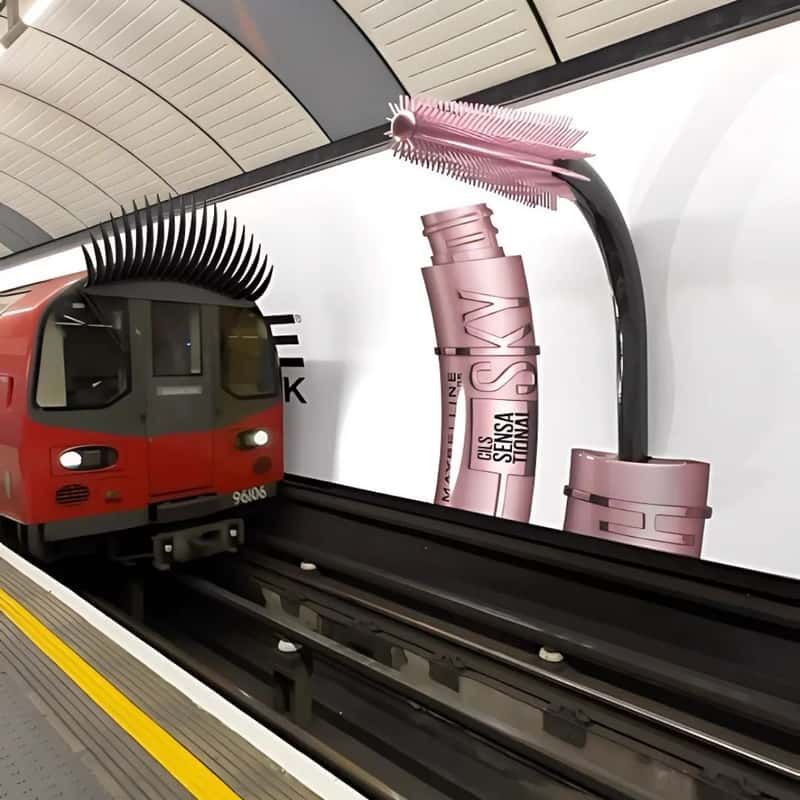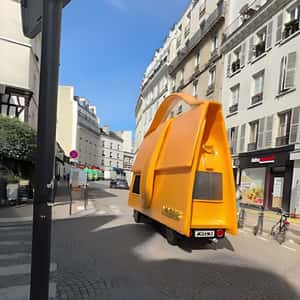What is FOOH or Fake Out of Home Advertising?
Learn everything about Fake Out of Home advertising in this guide, and how it can help you stand out in a crowded market.

If you’ve been on social media for a hot minute, you’ve probably come across a viral ad or two from a brand that uses a unique and almost hypnotizing style you’ve never seen before. Fake Out of Home Advertising, also known as FOOH, is making a splash across all industries – and for good reason.
This new-age type of advertising is transforming the way brands get the attention of an audience in a social media-savvy world, combining reality with CGI visuals to create a jaw-dropping and hyperrealistic video.
From impossible scenarios to larger-than-life installations, Fake Out of Home Advertising offers a creative edge that’s hard to ignore in today’s crowded digital landscape.
What is FOOH or Fake Out Of Home Advertising?
Fake Out of Home advertising (FOOH) is a new short-form format combining video footage of real-life locations or popular attractions with 3D elements through CG (computer-generated) technology. The result?
Hyperrealistic ads that create a visual illusion of absurd or impossible scenarios as if they exist in the real world.
Follow this Link to see an example of a Fake Out of Home Advertising in our FOOH Library:
This form of advertising has just hit the market in late 2023 and is yet to be clearly defined, so you may sometimes come across FOOH being referred to as CGI ads or CGI marketing.
These videos, usually 8 to 15 seconds long, are posted on social media platforms like Instagram, YouTube, TikTok, Meta, or LinkedIn.
CGI ads have grown in popularity in recent years, in part due to the rise of short-form content and because it provokes a question like, “Is this real or not?” from an online audience.
Platforms like TikTok and Instagram started favoring bite-sized and snappy content over the traditional and longer formats, and the demand for shorter yet catchy ads that hook the viewer in the first couple of seconds quickly grew.
And the rapid advancement of high-computing technology combined with the creativity of 3D studios and its artists helped in meeting that demand.
Thus, Fake Out of Home advertising is born. But why should you consider incorporating FOOH ads as part of your business practice or campaign? Let’s get into it.
Why Fake Out of Home Advertising is a Game-Changer
Fake-out-of-home advertising can bring unprecedented traffic and visibility to your brand with just a short and catchy video. This type of advertising is primed to go viral, giving you a unique opportunity to break through the noise and tap into new audiences.
Here are two main reasons why Fake Out of Home is transforming modern marketing strategies:
1. Creative freedom
CGI ads allow brands endless possibilities when it comes to design and storytelling. With FOOH ads, you can easily make anything out of nothing.
- Create visuals impossible in the real world
- Alter reality digitally in ways traditional advertising can’t
- Add fictional elements to authentic scenarios
- Develop concepts without physical production constraints
These videos give you the ability to add elements to real-life scenarios that seemingly appear in the real world, making people wonder if it’s true or not.
2. Increased engagement
The surreal nature of FOOH ads makes the initial impact hard to ignore. These hyperrealistic visuals naturally grab attention as viewers are drawn to the unexpected.
- Creates initial shock and confusion that drives reactions
- Compels users to like, comment, and share content
- Appeals to viewers beyond your target demographic
- Generates discussions about authenticity
- Increases stopping power in crowded social feeds
This means CGI ads cast a wider net than traditional ads, and are twice as likely to increase organic interaction, visibility, and reach, making your campaign more effective.
Still need some convincing? Check out this article on Reasons Why FOOH Should Be Part of Your Marketing Strategy.
3 Successful Fake Out of Home Advertising Examples
We’ve covered the basics of what makes FOOH advertising so powerful, but let’s take a look at some real-world examples that showcase just how effective it can be. These campaigns are perfect examples of how CGI marketing can transform iconic locations into even more eye-catching, imaginative spaces that attract a worldwide audience online.
1. BOSS Double B Giant Sewing Machine
In this FOOH ad for BOSS, we’re taken to the second floor of their store on the Avenue des Champs-Élysées in Paris. A huge sewing machine is hard at work, stitching the iconic Double B monogram onto fabric.
The impressive machine draws in passersby, inviting them to stop and watch as the intricate design comes to life.
Set against the chic backdrop of the store, it’s a clever way to showcase the craftsmanship and luxury that BOSS embodies. With 400k likes and a whopping 24 million views, this ad demonstrates how FOOH can elevate a brand’s presence in a visually striking and innovative way.
2. Adidas Adizero in Berliner Fernsehturm Tower
This CGI ad for Adidas kicks off with a sweeping aerial view of the Berliner Fernsehturm Tower in Berlin. Suspended from the tower is a giant Adidas Adizero Adios Pro Evo 1 shoe, giving the illusion that it’s perched high above the city. With “WORLD RECORD” displayed on the shoe, it cleverly taps into the excitement of the upcoming Berlin Marathon.
As the camera pans around, viewers are drawn to both the shoe and the iconic Berlin skyline, it’s no wonder this ad has racked up over 45k likes and 500 comments—it’s a brilliant showcase of what makes FOOH so effective and engaging.
3. Manchester City Drone-controlled Goal
Who says you can’t mix soccer with a bit of fun? In this FOOH ad for Manchester City, we’re on a soccer field in Abu Dhabi. Manuel Akanji controls a drone carrying a soccer goal while Julian Alvarez kicks the ball to Erling Haaland, who scores with ease.
The Etihad Towers are in the background, adding to the scene. This FOOH ad perfectly captures the team’s spirit and their connection to Abu Dhabi. It’s no wonder this ad has over 2 million likes and 5,000 comments – people can’t get enough of it!
Looking for more examples? You’ve come to the right place. Our FOOH library offers the largest collection of Fake Out of Home ads, featuring brands across different industries and showcasing how these ads have boosted their social media engagement. Don’t miss out.
Planning your first Fake Out of Home Advertising Campaign
Planning your first Fake Out of Home (FOOH) campaign requires careful and thoughtful planning, along with collaboration with a team of experts. During the conceptualizing phase, it’s essential to keep your brand message and goals at the forefront of every decision.
Here’s how the process is typically structured:
1. Concept forming & brainstorming
The success of a FOOH ad relies heavily on one key component: seamless and effective communication between the brand and the studio.
It starts with an initial briefing that includes:
- A clear discussion of the brand’s message
- Defining the target audience
- Outlining campaign objectives
Next comes the research phase. As ideas start to take shape, both teams collaborate to:
- Fill in gaps in understanding
- Refine creative concepts
- Align on execution
This iterative process ensures every idea resonates with the intended audience — creatively and strategically.
2. Video shoot
Once a solid concept is established, it’s time for the video shoot. But before filming begins, teams must ensure that:
- All legal and copyright considerations are in place
- The location authority has granted filming permission
- Actors and props are selected to align with the creative vision
During the shoot, attention to detail is key. Factors like:
- Lighting and camera angles
- The placement of social media buttons or UI elements …can significantly influence how convincing the final FOOH ad turns out.
A clear storyboard helps the videographer capture the right shots — and enables the 3D animation team to integrate effects seamlessly later on.
3. 3D magic
This is part of the post-production phase, where 3D elements are implemented using DCC programs like:
- Maya
- Cinema 4D
- Blender
- Houdini
Each element is tracked, aligned, and integrated with the original footage to create a realistic illusion.
Want to learn how motion graphics, audio design, and VFX work together to create the magic? Explore the tools behind FOOH ads
4. Compositing
Then comes compositing — the step where everything gets pulled together:
- Live video footage
- CGI elements
- Color grading
- Final visual effects
This step is crucial in enhancing realism and making the illusion truly convincing. A strong compositing job helps the added elements blend in so well that the viewer might not even realize what’s real and what’s not.
The result?
A fully rendered, hyper-realistic .mp4 that feels so real, viewers pause and ask: “Wait… is this actually happening?”
Don’t want to miss out on everything FOOH? Sign up for our newsletter below to stay ahead of the curve and get the latest updates, insights, and trends delivered straight to your inbox!
Fake Out of Home Advertising Is the Future
You might wonder if Fake Out of Home is just another fleeting trend. But FOOH isn’t a phase — it’s the natural evolution of how brands connect with audiences in an age dominated by digital storytelling and social media.
And as social media becomes more integral to the daily lives of consumers, people are increasingly drawn to content that’s different, fun, and offers something unique and of value to their lives.
Fake Out of Home answers this need by offering a level of interaction between brand and audience that is organic and genuine – something that’s difficult to come by in today’s crowded and overly curated digital space. And for those reasons, it’s clear the FOOH isn’t going anywhere soon and is here to stay.
Stay in the loop with all things FOOH! Subscribe to our newsletter for the latest updates, insights, and trends to help you stay one step ahead!



